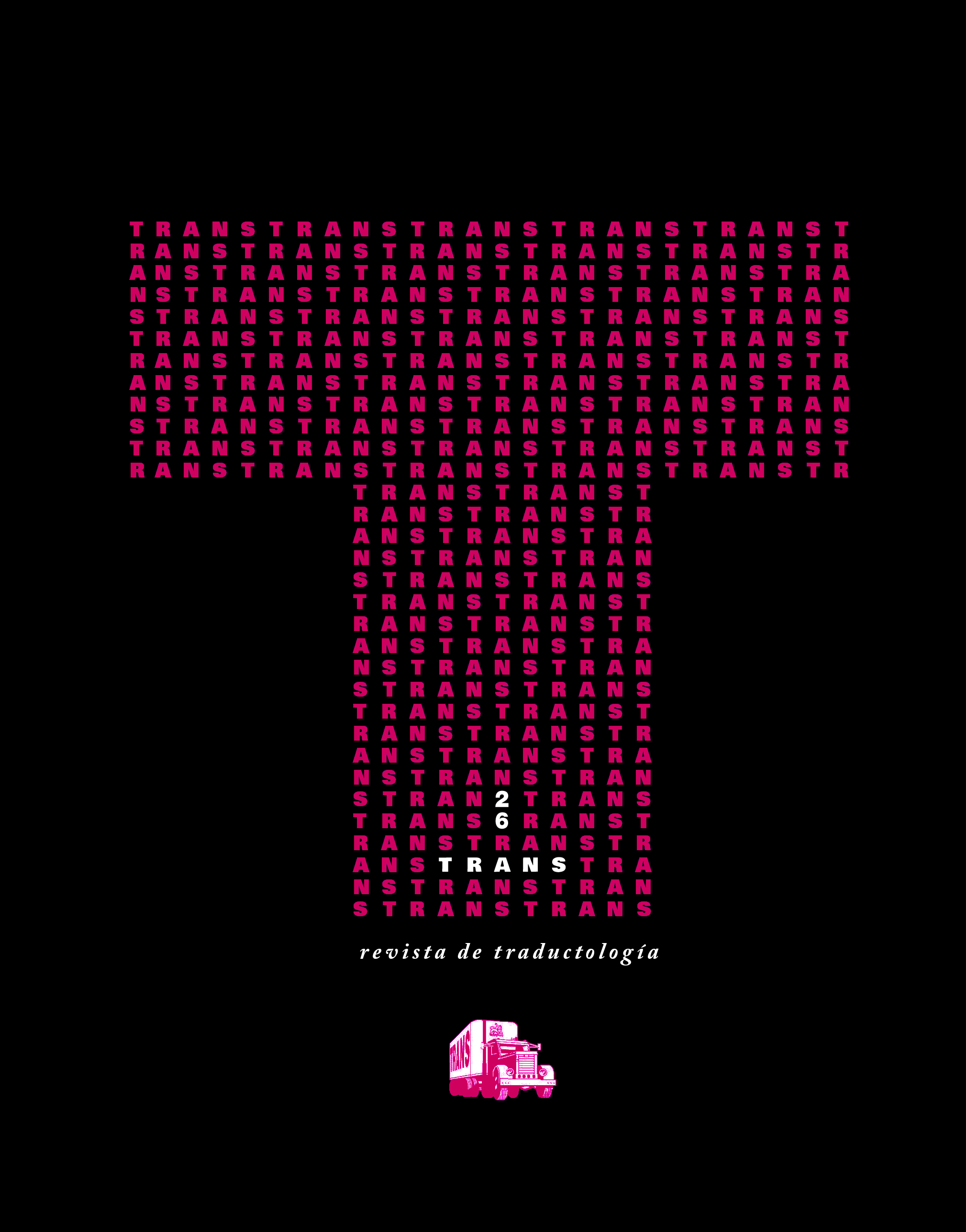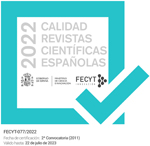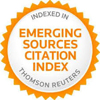Connectivity and situated cognition: an analysis of verbalizations around the translation process using grounded theory elements
DOI:
https://doi.org/10.24310/TRANS.2022.v26i1.12816Keywords:
translation process research, analysis of verbalizations, connectivity, situated cognition, grounded theoryAbstract
This article presents the theoretical basis and an exploratory study of exclusively conversational registers, collected thanks to connectivity (potential for interaction through technology), in a situated cognition framework during the execution of translation tasks in an online didactic environment. The aim is to bring out patterns of the translation process from verbalizations. The analysis takes place using the basic elements of the grounded theory: emergent research design, theoretical sampling, theoretical saturation, labelling and categorization of phenomena through the constant comparison method, as conceived by Strauss and Corbin (1998). The study, on ten verbalizations, is part of a project in which 200 conversations are being analyzed using this methodology with the help of the computer-assisted qualitative data analysis software, Atlas-ti.
Downloads
Metrics
Publication Facts
Reviewer profiles N/A
Author statements
Indexed in
-
—
- Academic society
- N/A
- Publisher
- Universidad de Málaga
References
Alves, F., y Vale, D. C. (2009). Probing the unit of translation in time: Aspects of the design and development of a web application for storing, annotating, and querying translation process data. Across Languages and Cultures, 10(2), 251-273. https://doi.org/10.1556/Acr.10.2009.2.5
Charmaz, K. (2014). Constructing grounded theory: A practical guide through qualitative analysis. Sage.
González Davies, M., y Enríquez Raído, V. (2016). Situated learning in translator and interpreter training: bridging research and good practice. The Interpreter and Translator Trainer, 10(1), 1-11. http://dx.doi.org/10.1080/1750399X.2016.1154339
Jääskeläinen, R. (2017). Verbal reports. En J. W. Schwieter y A. Ferreira (Eds.), The handbook of translation and cognition (pp. 213-231) Wiley-Blackwell. https://doi.org/10.1002/9781119241485.ch12
Keim, L., y Cánovas, M. (2020). Ensenyar i aprendre des de la connectivitat. En L. Keim (Coord.), Connectivitat i dimensió social en la docència de la traducció (pp. 13-20). Eumo.
Kiraly, D. (1995). Pathways to Translation. Pedagogy and Process. Kent State University Press.
Krings, H. (2001). Repairing texts: Empirical investigations of machine translation post-editing processes, trad. Geoffrey S. Koby, Gregory M. Shreve, Katja Mischerikow, Sarah Litzer. The Kent State University Press.
Muñoz Martín, R., y Martín de León, C. (2020). Translation and Cognitive Science. En F. Alves y A. L. Jakobsen (Eds.), The Routledge handbook of translation and cognition (pp. 52-68). Routledge. https://doi.org/10.4324/9781315178127
Muñoz Justicia, J., y Sahagún Padilla, M.A. (2017). Hacer análisis cualitativo con Atlas-ti 7. Universitat Autònoma de Barcelona. http://manualatlas.psicologiasocial.eu/atlasti7.html
PACTE (2003). Building a translation competence model. En F. Alves (Ed.), Triangulating translation: Perspectives in process oriented research (pp. 43-66) Benjamins.
Pavlovi?, N. (2007). Directionality in collaborative translation processes. [Tesis doctoral, Universitat Rovira i Virgili]. http://hdl.handle.net/20.500.11797/TDX549
Penalva Verdú, C., y Mateo Pérez, M. A. (2006): Tècniques qualitatives d’investigació. Universitat d’Alacant, Secretariat de Promoció del Valencià.
Risku, H. (2017). Ethnographies of Translation and Situated Cognition. En J. W. Schwieter y A. Ferreira (Eds.), The handbook of translation and cognition (pp. 290-310). Wiley-Blackwell.
Robbins, P., y Aydede, M. (2009) A Short Primer on Situated Cognition. En P. Robbins y M. Aydede (Eds.), The Cambridge handbook of situated cognition (pp. 3-10). Cambridge University Press.
Strauss, A. y Corbin, J. (1998): Bases de la investigación cualitativa: técnicas y procedimientos para desarrollar la teoría fundamentada, trad. Eva Zimmerman. Universidad de Antioquía.
Saivyer, R. K., y Greeno, J. G. (2009) Situativity and learning. En P. Robbins y M. Aydede (Eds.), The Cambridge handbook of situated cognition (pp. 347-367).
Cambridge University Press.
Sun, S. (2011). Think-aloud-based translation process research: Some methodological considerations. Meta, 56(4), 928-951. https://doi.org/10.7202/1011261ar
Downloads
Published
How to Cite
Issue
Section
License
All contents published in TRANS. Revista de Traductología are protected under the Creative Commons Attribution-NonCommercial-ShareAlike 4.0 International (CC BY-NC-SA 4.0) license. All about this license is available in the following link: <http://creativecommons.org/licenses/by-nc-sa/4.0>
Users can copy, use, redistribute, share and exhibit publicly as long as:
- The original source and authorship of the material are cited (Journal, Publisher and URL of the work).
- It is not used for comercial purposes.
- The existence of the license and its especifications are mentioned.
- ShareAlike — If you remix, transform, or build upon the material, you must distribute your contributions under the same license as the original.
There are two sets of authors’ rights: moral and property rights. Moral rights are perpetual prerogatives, unrenounceable, not-transferable, unalienable, imprescriptible and inembargable. According to authors’ rights legislation, TRANS. Revista de Traductología recognizes and respects authors moral rights, as well as the ownership of property rights, which will be transferred to University of Malaga in open access.
The property rights are referred to the benefits that are gained by the use or the dissemination of works. TRANS. Revista de Traductología is published in an open access form and it is exclusively licenced by any means for doing or authorising distribution, dissemination, reproduction, , adaptation, translation or arrangement of works.
Authors are responsable for obtaining the necessary permission to use copyrighted images.













21.png)
